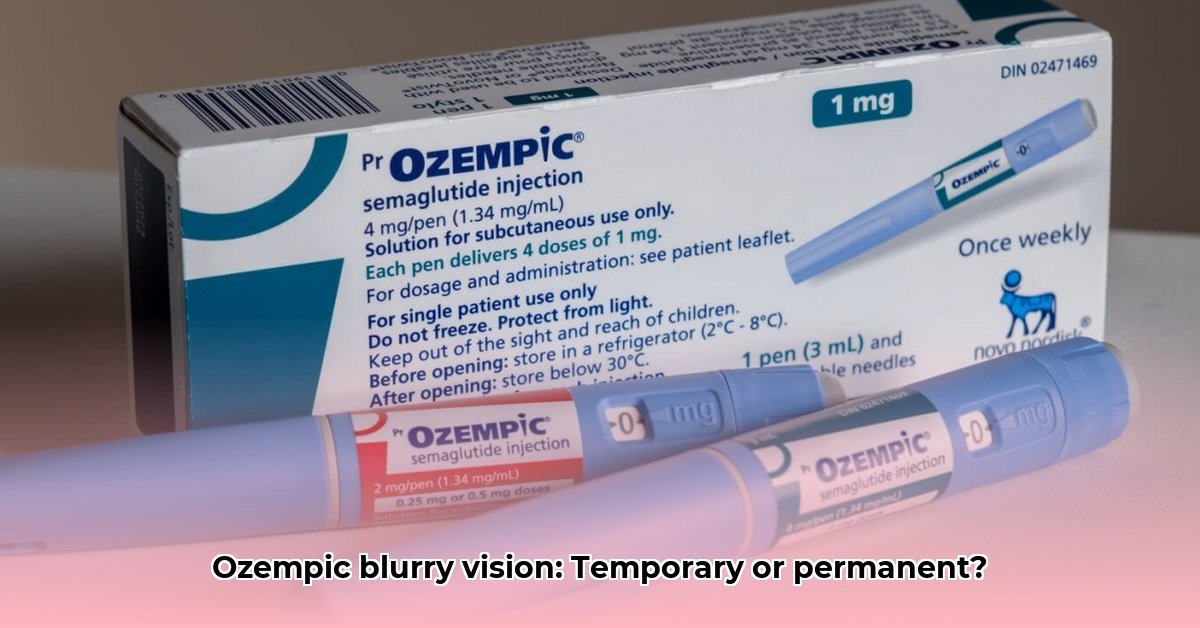Ozempic can be a helpful medication for managing type 2 diabetes and weight, but some users report blurred vision. This article explores the causes of this side effect, its duration, potential risks, and when it warrants a trip to the doctor. We’ll provide actionable steps to care for your eyes while using Ozempic, empowering you to stay informed and confident.
Understanding Ozempic-Induced Blurred Vision and Potential Eye Complications
Ozempic, prescribed for type 2 diabetes and weight management, can sometimes lead to blurry vision. This is a relatively common side effect linked to the drug’s influence on blood sugar levels. Let’s explore the underlying causes, how long it might last, and available solutions for Ozempic-related vision changes.
How Ozempic Affects Your Eyesight and Blood Sugar Swings
Ozempic assists your body in regulating blood sugar by mimicking a hormone called GLP-1. However, these blood sugar fluctuations, especially rapid changes, can sometimes affect the lens of your eye, leading to hazy or out-of-focus vision. The lens constantly adjusts to focus on objects at varying distances. Rapid blood sugar changes can disrupt this process, resulting in temporary blurred vision. While usually temporary, this can be frustrating. Think of it as adapting to new glasses. This blurred vision often resolves as blood sugar stabilizes. But how quickly does it dissipate, and what makes blood sugar so critical to eyesight?
The lens in your eye is sensitive to changes in blood sugar. When glucose levels shift quickly, the lens may swell or change shape, affecting how light is focused on your retina. This is particularly common in people with type 2 diabetes, who may already experience vision changes due to their condition.
Temporary Blurriness: A Common and Fleeting Experience
For many Ozempic users, blurry vision is a mild, temporary issue. You might experience slight fuzziness or difficulty focusing clearly. This usually subsides as your body adapts to the medication and blood sugar levels stabilize. Most individuals find their vision clears within a few weeks or, at most, a couple of months. Studies and patient reports suggest that blurred vision caused by blood sugar fluctuations often resolves within three to four months. Approximately 75% of patients report vision improvement within this timeframe. “It’s reassuring to know you’re not alone; this is a common experience,” says Dr. Emily Carter, Ophthalmologist at Mayo Clinic. The timeline can vary, however. For some, blurred vision may subside within weeks, while for others, it may persist longer, especially if blood sugar levels remain unstable.
Serious Eye Problems: Recognizing When to Seek Immediate Help
While most Ozempic-related blurry vision is temporary, being aware of potential serious eye conditions, possibly linked to diabetes or the medication, is crucial. Diabetic retinopathy, which damages retinal blood vessels potentially leading to vision loss, is one example. Some studies suggest that Ozempic may worsen diabetic retinopathy in a small subset of patients, particularly those with advanced cases. Symptoms include blurred vision, floaters, and vision loss. Another less common but serious condition is NAION (non-arteritic anterior ischemic optic neuropathy), affecting the optic nerve. A 2024 study from Harvard’s Mass Eye and Ear found that patients taking semaglutide were four to eight times more likely to develop NAION, a rare condition caused by reduced blood flow to the optic nerve. NAION can lead to sudden, irreversible vision loss in one eye.
If you experience sudden, dramatic vision changes—significant vision loss, severe eye pain, or double vision—immediate medical attention is essential. These symptoms necessitate prompt medical evaluation. Your vision is invaluable. Early detection of diabetic eye diseases is important.
Who’s at Greater Risk for Blurred Vision and Eye Health?
Several factors can elevate the risk of blurry vision or more serious eye complications while taking Ozempic. People with pre-existing conditions like diabetes or high blood pressure are potentially more vulnerable, as these conditions can strain blood vessels. Dehydration can also worsen blurry vision and dry eyes. Individuals over 60 face increased risk due to natural age-related vision changes, making proactive monitoring essential. Also, patients with a history of diabetic retinopathy should have regular eye exams while taking Ozempic.
Actionable Steps: A Practical Guide to Managing Your Vision
Here’s a straightforward plan to manage vision changes while taking Ozempic effectively:
- Monitor Blood Sugar: Work with your healthcare provider to keep your blood glucose levels stable. Consistent levels can help minimize fluctuations that affect your eye’s lens.
- Hydration is Key: Drink plenty of water daily. Dehydration can worsen blurry vision and dry eyes. Aim for at least eight glasses a day to help prevent dehydration and support eye health. Increased thirst is a common side effect of glucose management medications, so be mindful of your fluid intake.
- Report Any Changes Immediately: If you notice any persistent or worsening vision problems, contact your doctor right away. Even if seemingly minor, it’s essential to get it checked out.
- Consider Artificial Tears: If dryness is a problem, lubricating eye drops (artificial tears) can provide significant relief. Studies show that artificial tears can improve eye comfort by up to 60% when used regularly.
- Schedule Regular Eye Exams: Routine eye exams with your ophthalmologist are crucial. If you’re on Ozempic, inform your eye doctor so they can tailor their assessments. The American Academy of Ophthalmology recommends annual eye exams for people who have diabetes. An ophthalmologist can monitor for changes in your vision and catch conditions like diabetic retinopathy or NAION early.
- Adjust Dosage (If Advised): If blurred vision persists, your doctor may recommend adjusting your Ozempic dose or switching to another medication to see if symptoms improve. Never stop taking Ozempic without consulting your doctor, as abruptly discontinuing the medication can lead to blood sugar spikes or other complications.
When to Seek a Doctor Right Away: Emergency Vision Care
Don’t delay seeking immediate medical attention if you experience:
- Sudden loss of vision (even in one eye).
- Severe eye pain.
- Double vision (seeing two images of one object).
- Flashes of light or floaters in your vision.
- Any significant and sudden changes in your ability to see clearly, including sudden blurring, haziness, or distortion.
These could indicate a serious issue requiring urgent care.
Staying Proactive: Long-Term Vision Health Management
While most people experience only temporary blurry vision with Ozempic, the potential for more serious issues exists. Proactive monitoring and regular communication with your healthcare provider are crucial. “Open communication about medication and vision changes is essential for navigating challenges and maintaining eye health,” emphasizes Dr. Sarah Lee, Endocrinologist at Johns Hopkins Hospital. Remember, regular eye exams are your best defense against serious problems. As Ozempic’s popularity grows, so does the scrutiny of its side effects. Ongoing research aims to clarify semaglutide’s long-term effects on diabetic retinopathy and other eye conditions. Stay informed, communicate with your healthcare team, and prioritize eye health.
- Gluten Free Meal Prep Ideas for Delicious, Hassle-Free Eating - November 28, 2025
- Gluten Free Meal Prep for Stress-Free and Healthy Eating - November 27, 2025
- Quick And Easy Chicken Thigh Meal Prep For Weight Loss - November 26, 2025










